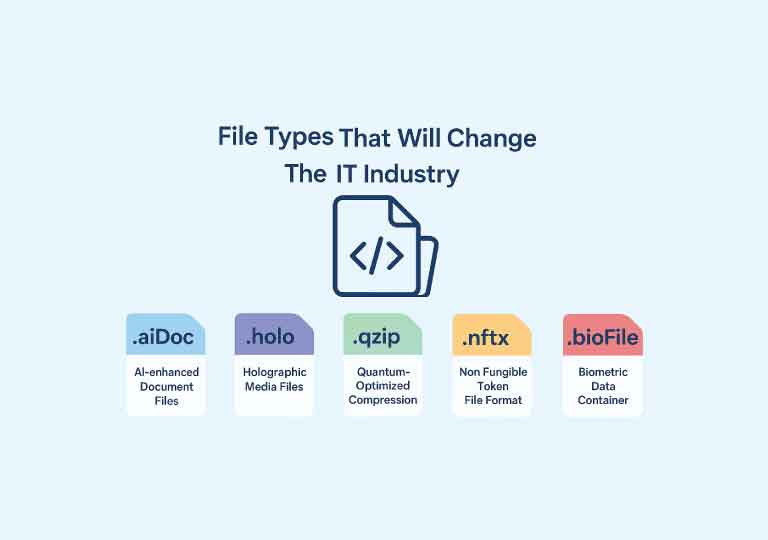.docx, .jpg, .mp4, and .pdf have reigned supreme in the IT world for years—but the future will bring something smarter, leaner, and more dynamic.
In this article we take a look at the emerging, speculative file formats of the future, the technologies that will open them for use, and the way in which they’re set to change the IT landscape as we know it.
Why Do File Types Matter?
File formats describe how information is encoded, as well as how it is interpreted, shared, and protected. They directly impact:
- Software compatibility
- File size and performance
- Data security and encryption
- Cross-platform usability
- User experience
With industries moving towards cloud computing, AI technologies, and more immersive media, the demand for smarter and more adaptive file formats is only growing.
Future-Ready File Types to Watch
1. .aiDoc — AI-enhanced Document Files
Think of a .docx, but powered by AI. AI-Enhanced Documents could feature:
- Context-aware editing
- Live data visualization
- Real-time translation and summarization
- Embedded conversational interfaces
Use Case: Legal, research and corporate documents with embedded smart assistants.
2. .holo — Holographic Media Files
The evolution of AR/VR and holography will naturally give rise to a new file format for 3D, immersive content.
- Includes volumetric video and spatial audio
- Made for AR Glasses, VR Headset & Holographic Displays
- Could potentially use AI to dynamically scale quality across hardware
Use Case: Training simulations, holographic advertising and virtual meetings.
3. .qzip — Quantum-Optimized Compression
Quantum computing will demand new ways of handling information:
- Ultra-efficient compression using quantum principles
- High-speed data unpacking
- Secure by construction based on Quantum Entanglement
“We’ve also begun work on allowing for even larger object store deployments. There are a bunch of cool new features in OpenZFS, with the biggest among them allowing you to store far more stuff in the file system itself. We’re now working on expanding the limits of the object store capabilities itself.” — Saunders
Use Case: Big data transfer, secure archives, advanced scientific research.
4. .nftx — Non Fungible Token File Format
When blockchain adoption matures, files with NFTs or smart contracts embedded will become common.
- Contains verifiable ownership metadata
- File itself has smart contract interaction baked in
- Unchangeable history of edits/transactions
Applications: Digital Art, Licenses, Owning Media Assets.
5. .bioFile — Biometric Data Container
Created for secure identity, health and access management applications.
- Encodes data matching fingerprints, retinal images, voice recordings, or a DNA sample
- Encrypted and GDPR-compliant
- Verifiable on zero-trust architectures
Use Case: Medical work, border control, secure logins.
The IT Industry Impact
Software Development
Developers will have to build apps that understand a new crop of “smarter” file types—so frameworks, SDKs, and APIs also will have to keep pace. Integrated AI, VR or even blockchain will be table stakes, not nice-to-haves.
Cloud Infrastructure
These files will have to be natively supported by cloud providers like AWS, Azure, or Google Cloud. This includes storage, optimizations and security measures for new formats.
Cybersecurity
New file formats mean new places to attack. Encryption that is quantum-safe, access that is tokenised, and trust that is embedded will become must-haves for IT security professionals.
Creative Industries
Video, design, and 3D modeling will move toward file formats that support efficient compression, quality scaling, and more immersive experiences—ushering in new digital storytelling innovations.
AI & Automation
AI will not just run on these file formats but be baked into them. Files will be semi-autonomous, able to update themselves, talk to APIs, or recommend content based on user interests.
Challenges to Consider
- Backward compatibility: Will old systems accept new formats?
- Standardization: Chaos may result without standardized norms around the world.
- Data Sovereignty: Ownership of embedded intelligence will raise regulatory issues.
- Learning Curve: New formats will require training for developers and users.
Conclusion
The future of file formats is not only about preserving information but also activating it. In the matured digital ecosystem, we will progress to smarter, adaptive, secure file types, which will redefine interactions with technology.
Be it holographic presentations, AI-engineered contracts, or quantum-compressed archives—the new age of file types is all set to change the game of efficiency, creativity and control in the IT realm.
Visit Fileconvertz for all your file conversions